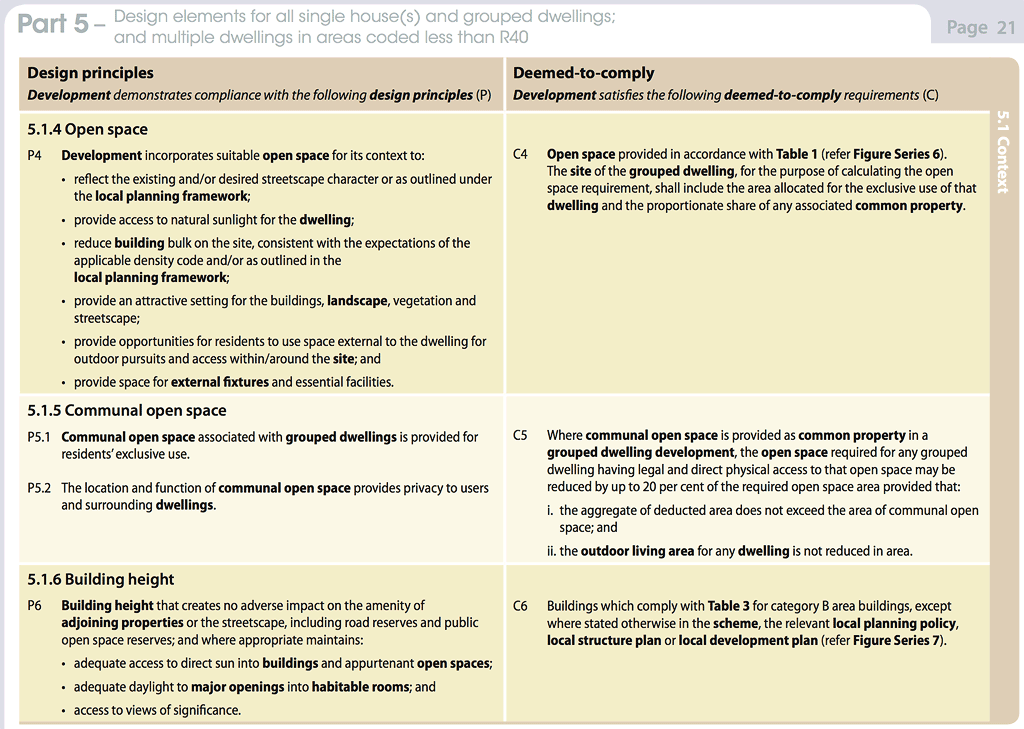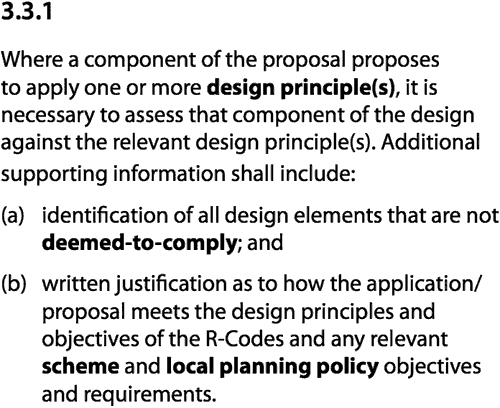Introduction
The Residential Design Codes (R-Codes) were introduced in Western Australia in 1985 and govern the design of most residential developments throughout the state. Since that time, the codes have evolved into what I believe is a pretty useful and thoughtful document that encourages designers to not just blindly follow a set of prescribed standards, but to carefully consider the outcomes that those standards are intended to achieve and to design accordingly. It does this by clearly defining both the desirable outcomes or design principles for each clause and providing an example set of provisions that, if strictly adhered to, will be automatically deemed-to-comply without requiring any justification.

The code is clear in its recognition that adhering to the prescribed deemed-to-comply provisions will not always result in the best possible outcomes for every site. However, with the experience of planners and policy-makers over many years, those generic provisions have evolved into a reasonable compromise for achieving the overall amenity protections and planning goals for each region. However, they are not intended in any way to be the absolute rules. They are simply the path of least resistance for anyone wanting to develop a site – adhere to those provisions and approval is guaranteed with reasonable outcomes for all involved.
To encourage even better outcomes, the R-Codes provide scope for a design to be assessed against the design principles that underpin each clause rather than the deemed-to-comply provisions, as long as there is clear justification and evidence of an equal or better outcome. These two paths to compliance are clearly defined in the codes, as shown in Figure 2.

The code is also very explicit in stating that, in such situations, the deemed-to-comply provisions should not be considered as the criteria against which that justification is to be assessed, as those provisions are just a single example of how one might comply, and not the only way.

As someone who has spent their entire career as an enthusiastic proponent and practitioner of performance-driven building design in both academia and consulting, this appears to be a refreshing and progressive approach. It allows anyone to confidently create an unequivocally compliant design whilst at the same time providing architects with clear performance goals and a set of principles to design for as well as the scope to balance these with wider considerations such as energy efficiency and long-term sustainability.
However, all is not entirely as it seems.
Implementation
Before considering any proposal in detail, the planning department of each council is required to advertise it and notify surrounding neighbours and other stakeholders by letter. As a matter of course, these notification letters contain a detailed list of all the ways the proposed design varies from the generic deemed-to-comply provisions, regardless of whether the design is being assessed against design principles or not, and without any reference to the detailed justification for those variations. The result is that notification letters for designs that blindly follow the deemed-to-comply provisions, without any consideration of the potential impact on their particular surroundings, will either not be sent or be very brief in stating full compliance.
If an architect, encouraged by the R-Codes themselves, chooses to carefully consider the specifics of their particular site and apply their professional training and experience to create a design that achieves objectively better outcomes, the resulting notification letter will invariably contain multiple pages of detailed variations. Depending on the internal procedures of individual planning departments, these letters may or may not include a brief explanation of the relationship between deemed-to-comply and design principles, and may or may not include prejudicial language in each variation such as stating that the design does not ‘comply’ with or does not meet certain ‘required’ or ‘allowable’ metrics.
Thus, even though a proposal may end up being assessed as completely justified based on design principles, and therefore fully compliant with the R-Codes, the impression given by the notification letter to neighbours and the surrounding community is of a design that is really pushing the envelope and asking for way more than everyone else is ‘allowed’. Also, if the planning officer’s report does ultimately support the proposal, the disconnect between so many apparent variations and yet full support by the planning department leads to confusion and suspicion amongst neighbours that the architects somehow ‘got away with it’ or played the system in their favour.
Legacy Issues
Obviously the planning officer needs to write something about the design in the notification letter, and comparing it with the deemed-to-comply provisions is probably a useful first take as it offers a fairly straightforward way of determining which parts of a design will likely need more of their attention than others. However, its effectiveness as an internal processing tool does not necessarily make it effective for external communication, especially to lay people who may not be familiar with the dual paths to compliance or even that deemed-to-comply provisions do not apply when addressing design principles.
This is further exacerbated when no mention is made in the notification letter of any of the detailed justifications provided by the applicant as part of their supporting documentation. In the projects I have been involved with, only the drawing sets are ever made available to the public as part of the advertising process. Any supporting material such as the detailed justification is only ever read by the planning officer when preparing their report, and not even provided to councillors who will subsequently vote on the proposal.
It has also been my experience that this heavy focus on deemed-to-comply provisions permeates through almost every level of planning. Even senior planners will refer to a proposal as being ‘over height’ or ‘outside allowable’ setbacks, well before any determination of compliance against design principles has even been attempted.
To be fair to the planners, there are still clauses in the R-Codes that reinforce this approach, despite its other efforts not to. For example, 4.1.2(d) requires that the notification letter be written in a way that invites comment only on variations from the deemed-to-comply provisions. This is tempered somewhat by clause 4.1.5 which requires the notification to also direct that those comments focus only on the design principles that govern those variations.

Thus, the R-Codes may appear to encourage architects to innovate in their pursuit of better performing and less impactful designs, but the implementation is often heavily stacked against any design innovation that deviates from the deemed-to-comply provisions that everyone is so familiar with.
Potential Solution
Obviously I am not a planner and certainly do not deal with this on a daily basis, so all I can really do is pontificate a little. However, it would appear that a potential solution to this would involve the following:
- Having councils interpret clause 3.3.1 more strictly and require applicants to nominate at submission those aspects of the proposal they would like assessed against design principles instead of deemed-to-comply, and have them provide the required written justification as part of the submitted documentation. Obviously the planning officer still has to examine the design to ensure that those nominated are the only variations, however this makes it much clearer to applicants right from the very start that variations need adequate justification.

- That planning officers more strictly adhere to clause 4.1.5 and, when listing each variation in the notification letter, also outline the relevant design principles involved in that variation and clearly state whether or not the applicant has provided justification against them – noting as well that no determination of compliance or otherwise has yet been made. Again, this makes it clearer to those potentially affected by the proposal that compliance involves judgement and isn’t entirely black and white.

Make the supporting material provided by the applicant as justification against design principles available to the public for inspection at the council offices alongside the drawing sets and, if in a suitable format, also on the council website. This has always been the case for proposals dealt with by a Development Assessment Panel (DAP), so it seems reasonable for local planning applications also.
Some rewording of Section 4.2.1(d) in order to better reflect the premise stated in Section 4.1.5. An example might be something like:
(d) due date by which any comments are to be lodged with the decision-maker, being at least fourteen (14) days after date of posting of notification, or as specified within the scheme, and invited to comment on that part of the proposed development that seeks or requires assessment against the design principles provisions of the R-Codes.

Conclusion
The benefit of this approach is transparency – informing neighbours and the community that compliance is somewhat more complex than simply ‘trying it on’. At the moment, people see a new proposal with a large number of variations that gets approved, then either feel aggrieved that they should have asked for more themselves or resolve to have their own proposal push the envelope just as far or even further next time. This is primarily because there is very little communication about the design principles justification process and exactly how each design is assessed on its merit. Sure, all of this is in the R-Codes, but that is rarely read and understood in its entirety by anyone outside planning and design.
Click here to comment on this page.